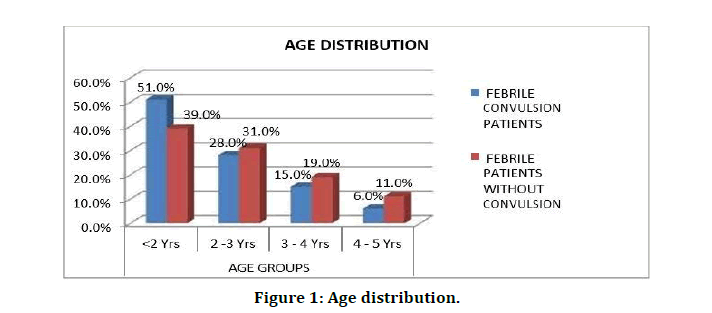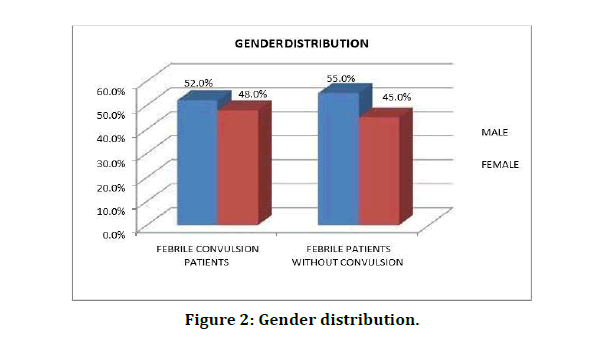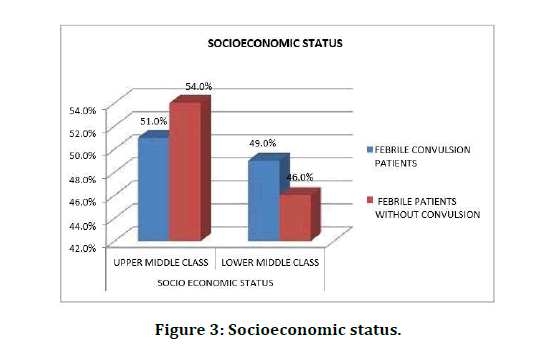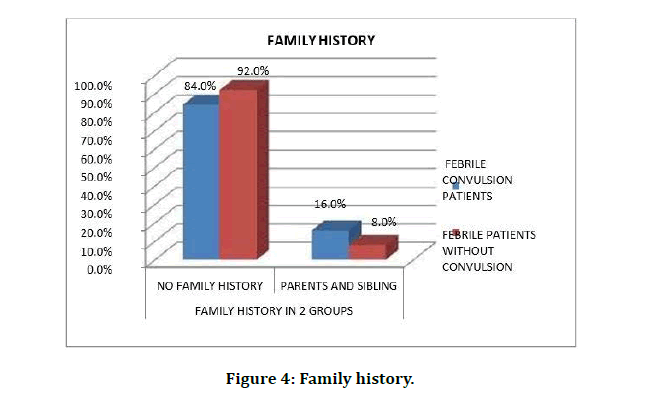Research - (2021) Volume 9, Issue 5
A Study of Serum Zinc Levels in Children with Simple Febrile Convulsions in Comparison with Febrile Children Without Convulsions
Dunnuthala Sreenivasulu Reddy and S Sundari*
*Correspondence: S Sundari, Department of Pediatrics, Sree Balaji Medical College & Hospital Affiliated to Bharath Institute of Higher Education and Research, Chennai, Tamil Nadu, India, Email:
Abstract
The present study compares the serum zinc level in children with simple febrile convulsions with febrile children without convulsions and to study the clinical profile of the study population. URI was the most common cause for the febrile convulsion children. Our study showed that 84% of the children with febrile seizure did not have positive family history for febrile convulsions. Only 16% of parents and siblings were found to have positive family history. The present study focuses on chance of developing febrile convulsion upper middle-class children with lower middle-class children. The mean serum zinc levels in children with febrile convulsions and the serum zinc levels in children with fever without convulsion were statistical significance. our study includes that decreased serum zinc levels can also be one of the predisposing factors for febrile convulsions in children from 6months to 5 years.
Keywords
Serum zinc level, febrile, fever, URI, statistical and convulsions
Introduction
A seizure is a transient occurrence of signs and/ or symptoms resulting from abnormal excessive neuronal activity in the brain. Approximately 30% of patients who have a first a febrile seizure later develop epilepsy [1]. Febrile seizure is the most common form of seizures, it is 2-fold more common in boys than in girls. The mechanism of febrile seizure has multi factorial etiology, febrile seizure occurs with fever (temperature>38 0C) and without symptoms of CNS infections. However, sometimes these seizures signify major structural, inflammatory, or metabolic disorders of the brain, such as meningitis, encephalitis, acute stroke, or brain tumor. An unprovoked seizure is one that is not an acute symptomatic seizure. Remote symptomatic seizure is one that is secondary to a distant brain injury, such as old stroke. Reflex seizures are usually precipitated by a sensory stimulus such as flashing lights. Infants and children have more chance to have seizures than adults. This reflects the greater neuronal excitability at certain ages as the excitatory glutamate system and inhibitory GABA system do not always balance each other. This results in a tendency to exhibit symptomatic seizure related to high fever, infections, minor asphyxia, medication, bacteria toxins and biochemical disturbances like hyponatremia, hypernatremia, hypocalcemia etc.The clinical diagnosis of epilepsy usually requires the occurrence of at least one unprovoked epileptic seizure with either a second such seizure or enough EEG and clinical information to convincingly demonstrate an enduring predisposition to develop recurrences [1]. Zinc is an essential mineral that is obtainable as dietary supplement. Zinc is essential for proper growth and development. An important catalyst for 100 specific enzymes. Zinc is essential for the wound healing, DNA synthesis, immune function, protein synthesis and cell growth. A few of zinc dependent enzymes include carbonic anhydrase, alkaline phosphatase, carboxypeptidase, superoxide dismutase, phospholipase C etc. Zinc plays a major role in tissue growth. This is related primarily to its function in the regulation of protein synthesis as well as synthesis and catabolism of nucleic acids. With respect to transcription, zinc appears to interact with nuclear proteins that bind to promoter sequences of specific genes. DNA base pairs which are recognized by zing fingers during DNA replication and transcription. The metallothionein gene, synaptic signaling, and apoptosis, all are regulated by zinc. Zinc is extremely important to the functional development of polymorphonuclear cells and antigen presenting cells. Zinc plays an important role in regeneration of intestinal mucosa, wound healing, and epithelial cell turnover. These functions explain why zinc plays such an important part in the protection against infections. Numerous studies have been done to analyze the role of trace elements in febrile convulsions. Studies have shown that hypozincemia predisposes to febrile convulsions and many such studies have been done in Iran, Turkey, and Bangladesh. Two studies done in India one at Chennai and one at Mumbai have shown similar results. This study has been done in Sree Balaji Medical College and Hospital to check if the results of previous studies hold good for the population in and around the vicinity of Chennai.
Materials and Methods
Place of study
Sree Balaji Medical College and Hospital - Paediatric Department.
Design of study
Case control study.
Period of study
April 2017 to March 2018.
Sample size
✓ Sample size of 100 was selected for each group.
✓ Children with simple febrile convulsions.
✓ Children with fever without convulsions.
Inclusion criteria
✓ Children aged six months to five years with first episode of simple febrile convulsions.
✓ Children aged six months to five years with fever without convulsions.
Exclusion criteria
The following children were excluded from the study.
✓ Cerebral palsy.
✓ Seizure disorder.
✓ Chronic diseases.
✓ Weight <70% of expected.
✓ Complex febrile seizure.
✓ Children on zinc preparations.
✓ Recurrent febrile seizure.
✓ Children on anti convulsants.
Methods
This study included 200 children aged between 6 months and 5 years. Among them 100 children who had presented with first episode of simple febrile seizures, formed the cases and 100 children who had fever without seizures formed the controls. The materials used in this study were acid propylene washed test tubes, IV cannula, scalp vein set, Test tube stand, centrifuge, serum collection test tubes, and refrigerator.
Informed consent of the parents of the two groups of children was obtained in a printed consent form in Tamil as the predominant population was illiterate. Any questions or doubts were cleared by the examining physician in Tamil and the signature of the parent or left-hand thumb impression was obtained. A thorough history like duration of fever, time of onset of seizures, type of seizures, duration of seizures, past history of seizures and family history of seizures were noted. In addition, history suggestive of any triggering factors for the febrile episode like cough and cold, nasal discharge, ear discharge, burning micturition or crying during micturition were also recorded.
Vital signs namely heart rate: respiratory rate and blood pressure were measured and recorded. The axillary temperature was measured for 3 minutes in the axilla by using digital thermometer. Anthropometric measurements (weight, height, mid- arm circumference and head circumference) were recorded. Those children whose weight less than 70% of expected, Height less than 12.5 cm, mid arm circumference less than 12.5 cm (Applicable for children 1 -4 years of age) and head circumference less than the third centile were excluded.
This was followed by general examination and systemic examination in detail. Those children who showed features of any chronic congenital or acquired illnesses were excluded. Patients with signs and symptoms suggestive of CNS infections (meningeal signs, bulging anterior fontanel and altered sensorium) were excluded. Three milliliters of whole blood were collected by venipuncture under strict aseptic precautions in sterile metal free acid propylene washed plastic test tube. The sample could stand without any disturbance for five hours to enable settling down of erythrocytes. Then the serum was separated by centrifuging at 2500 revolutions per minute under aseptic conditions. The serum alone was removed and transferred to acid washed plastic collection tube which was properly labeled. The tube was sealed tightly and stored in the freezer compartment of the refrigerator till transfer to Hitec healthcare laboratory &research center. Where the zinc levels were measured, the serum zinc levels were measured by atomic absorption spectrometry - Perkin Elmer Model 2380 as per the procedure already described. The analyzing personnel were blinded about the clinical details of the samples in order to prevent investigator bias.
Results
This study was a case control study, conducted at Sree Balaji medical college and hospital, wherein the serum zinc levels in two groups of children, one group consisting of children with simple febrile seizure and other group consisting of children with febrile illness without convulsions were compared. The data collected was entered by a data entry operator and analyzed by a statistician using SPSS software. The following test statistics were used in the analysis.
✓ Chi Square test.
✓ Two sample T test.
✓ Bivariate Correlations.
In Table 1 and Figure 1, the febrile convulsions group of children were 51% below 2 yrs. of age, 28% between 2 to 3 yrs., 15% between 3 to 4 yrs. and 6% were between 4 to 5 yrs. of age. Whereas in the fever group 39% were below 2 yrs. of age, 31% between 2 to 3 yrs,19%between 3 to 4 yrs. and 11% were between 4 to 5 yrs. of age. This result shows there is no statistical significance. Thus, the groups were comparable with respect to age distribution.

Figure 1: Age distribution.
Table 1: Age distribution.
| Age Groups | Groups | Total | ||
|---|---|---|---|---|
| Febrile convulsion patients | Febrile patients without convulsion | |||
| <2 Yrs. | Number | 51 | 39 | 90 |
| % | 51% | 39.00% | 45.00% | |
| 2-3 Yrs. | Number | 28 | 31 | 59 |
| % | 28.00% | 31.00% | 29.50% | |
| 3-4 Yrs. | Number | 15 | 19 | 34 |
| % | 15.00% | 19.00% | 17.00% | |
| 4-5 Yrs. | Number | 6 | 11 | 17 |
| % | 6.00% | 11.00% | 8.50% | |
| Total | Number | 100 | 100 | 200 |
| % | 100.00% | 100.00% | 100.00% | |
P=0.296 (not significant)
In Table 2 and Figure 2, among children with febrile convulsions 48% were females 52% were males and among febrile children 55% were female 45% were males. The above result shows that there is no statistical significance. Thus, the two groups were comparable with respect to gender distribution.

Figure 2: Gender distribution.
Table 2: Gender distribution.
| Gender | Groups | |||
|---|---|---|---|---|
| Febrile convulsion patients | Febrile patients without convulsion | Total | ||
| Male | Number | 52 | 55 | 107 |
| % | 52.00% | 55.00% | 53.50% | |
| Female | Number | 48 | 45 | 93 |
| % | 48.00% | 45.00% | 46.50% | |
| Total | Number | 100 | 100 | 200 |
| % | 100. 0% | 100. 0% | 100. 0% | |
P=0.777 (not significant)
In Table 3 and Figure 3, 51% belong to kuppuswamy class II and 49% belong to kuppuswamy class III in the febrile convulsions group. Whereas in the febrile group 54% belong to class II & 46% belong to class III. Thus, the above result shows there is no statistical significance. Thus, the two groups were comparable with respect to distribution of children among class II & class III Socioeconomic status.

Figure 3: Socioeconomic status.
Table 3: Socioeconomic status.
| Socioeconomic status | Groups | Total | |||
|---|---|---|---|---|---|
| Febrile convulsion patients | Febrile patients without convulsion | ||||
| Socio Economic Status | Upper Middle Class (Class II) | Number | 51 | 54 | 105 |
| % | 51.00% | 54.00% | 52.50% | ||
| Lower Middle Class (Class III) | Number | 49 | 46 | 95 | |
| % | 49.00% | 46.00% | 47.50% | ||
| Total | Number | 100 | 100 | 200 | |
| % | 100. 0% | 100. 0% | 100. 0% | ||
P=0.777 (not significant).
In Table 4 and Figure 4, the family history of febrile convulsions group had a positive history of 16% and 84% did not have positive history. In the family history of febrile group 8% had a positive family history and 92% of the children did not have the positive history. Thus, the above result shows there is no statistical significance.

Figure 4: Family history.
Table 4: Family history.
| Family history | Groups | ||||
|---|---|---|---|---|---|
| Febrile convulsion patients | Febrile patients without convulsion | Total | |||
| Family history | No family history | Number | 84 | 92 | 176 |
| % | 84.00% | 92.00% | 88.00% | ||
| Parents and sibling | Number | 16 | 8 | 24 | |
| % | 16.00% | 8.00% | 12.00% | ||
| Total | Number | 100 | 100 | 200 | |
| % | 100. 0% | 100. 0% | 100. 0% | ||
P=0.128(not significant)
Discussion
This study was conducted to determine whether children with febrile convulsion had low serum zinc levels compared to children with fever alone. The two groups of children were comparable with respect to age, sex, and socioeconomic status. The mean age of febrile convulsions was 25 months in this study. Previous studies reported a mean age of 18 months and all other studies reported mean age of onset between 20 and 25 months. Positive family history was present in 16% of children with febrile convulsion in this study. This is significantly less when compared to other studies. Some authors have reported an incidence of 30% in his study. Other previous studies reported 20% of children with positive family history in his study. Some researchers have reported positive family history in 29% of cases. However, the finding that children with positive family history had earlier age of onset of febrile convulsions as shown in these studies, was present in our study also. The mean age of onset was 30.7 months in children with positive family history which is more compared to 26.6 months. Viral illnesses are the predominant cause of febrile convulsions. In this study upper respiratory tract infection was found to be the triggering illness in 38% of children. lower respiratory tract infection and Acute gastroenteritis contributed 15% and 13% and urinary tract infection contributed 12%. In 14% of children there were no localizing signs associated with fever. Upper respiratory tract infection is the most common trigger which was also reported in studies.
The mean serum zinc levels were 64.92mcg/ dl, 81.03mcg/dl respectively, in children with febrile convulsions and in children with fever alone. Children with febrile convulsions have statistically significant low serum zinc levels when compared with children having fever without convulsions. However, some previous studies have shown that serum zinc levels is decreased in children with fever though the magnitude of decrease was not as much as in children with febrile convulsions. No significant correlation of serum zinc level had seen with age of onset, sex, axillary temperature in our study. All the previous studies have shown similar findings in this aspect. The mean serum zinc level in children with fever in our study is 81.03mcg/ dl. Which is again less than the corresponding value. Many factors such as dietary pattern, vitamin A, vitamin D deficiency, zinc level in soil and water influences the serum zinc level in all population. Further studies are need in this aspect to identify the probable cause for this finding [2-25].
Conclusion
This study shows that serum zinc levels are decreased in children with simple febrile convulsions, thus indicating that zinc deprivation plays a significant role in the pathogenesis of febrile convulsions.
Funding
No funding sources.
Ethical Approval
The study was approved by the Institutional Ethics Committee.
Conflict of Interest
The authors declare no conflict of interest.
Acknowledgements
The encouragement and support from Bharath Institute of Higher Education and Research, Chennai is gratefully acknowledged. For provided the laboratory facilities to carry out the research work.
References
- Livingston S. Comprehensive management of epilepsy in infancy, childhood, and adolescence. Spring field IL: Charles C Thomes 1972.
- American Academy of Pediatrics. Febrile seizures: Long-term management of children with fever-associated seizures. Pediatrics 1980; 66:1009-10012.
- http://www.epilepsiaecuador.org/campusabbot/modulos/documentos/modulo2_LECTURA_5.pdf
- Matsuo M, Sasaki K. Increased IL-Iβ production from leucocytes in febrile seizures. Pediatr Neurol 2006; 35:102-106.
- Gatti S, Vezzani A. Mechanisms of fever and febrile seizures. Putative role of IL-1 system febrile seizures. San Diego, Ca: Academic press 2002; 169-188.
- Haspolat S, Mihci E. IL Iβ, TNF-α and nitrite levels in febrile. J Child Neurology 2002; 17:749-751.
- https://pediatrics.aappublications.org/steering_committee_on_quality_improvement_and_management
- Sugai K. Current management of febrile seizure in Japan an overview. Brain Dev 2010; 32:64-70.
- Stafstrom CE. The incidence and prevalence of febrile seizures. in: Baram TZ, Shinnar S, editors. Febrile Seizures. San Diego: Academic press 2002; 1-25.
- Sisodiya S. Feverish prospects for seizure genetics. Nature Genetics 2014; 46:1255-1256.
- Wallace RH, Marini C, Petrou S, et al. Mutant GABA A receptor gama2 subunit in childhood absence epilepsy and febrile seizure. Nat Genet 2001; 28:49-52.
- Audenart D, Van Broorkhoven. Genes and loci involved in febrile seizures and related epilepsy syndromes: Hum Mutat 2006; 27:391-401.
- Frank H, Mantegazza M, Westenbroek RE, et al. Reduced sodium current in GABAergic interneurons in mouse model of sever myoclonic epilepsy in infancy. Nat. Neurosci 2006; 9:1142-1149.
- Visser AM, Jaddoe VM, Hofman A, et al. Fetal growth retardation and risk of febrile seizure. Pediatrics 2010; 126:919-925.
- Vestergaard M, Christensen J. Register -based studies seizure in Denmark. Brain Dev 2009; 31:372 -377.
- Derakhshanfar H, Abaskhanian A, Alimohammadi H, et al. Association between iron deficiency anemia and febrile seizure in children. Med Glas 2012; 9:239-242.
- KUmari PL, Nair SM, Kailas L, et al. Iron deficiency as a risk factor for simple febrile seizures-a case control study. Indian Pediatr 2012; 49:17-19.
- Heydarian F, Vatankhah H. The role of anemia in first simple febrile seizure in children aged 6 months to 5 years old. Neuroscience 2012; 17:226-229.
- Ganesh R, Janakiraman L. Serum zinc level in children with simple febrile seizure. Clin (Phila) 2008; 47:164-166.
- Schuchmann S, Hauck S, Henning S, et al. 2011; Respiratory alkalosis in children with febrile seizure. Epilepsia 2011; 52:1949-1955.
- https://www.us.elsevierhealth.com/nelson-textbook-of-pediatrics-2-volume-set-9780323529501.html
- Paul SP, Blaikley S, Chinthapalli R. Clinical Update: Febrile convulsion in childhood. Community Pract 2012; 85:36-38.
- Rabbani MW, Ali l, Latif HZ, et al. Serum zinc level in children presenting with febrile seizures. Pak J Med Sci 2013; 29:1008-1011.
- Ali Reza, Moayedi, Eftekhaari, et al. Febrile seizures: factor affecting risk or recurrence. J Pediatr Nephrol 2008; 6:341-344.
- https://www.elsevier.com/books/nelson-textbook-of-pediatrics-first-south-asia-edition-3-volume-set/kliegman/978-81-312-4370-1
Author Info
Dunnuthala Sreenivasulu Reddy and S Sundari*
Department of Pediatrics, Sree Balaji Medical College & Hospital Affiliated to Bharath Institute of Higher Education and Research, Chennai, Tamil Nadu, IndiaCitation: Dunnuthala Sreenivasulu Reddy, S. Sundari, A Study of Serum Zinc Levels in Children with Simple Febrile Convulsions in Comparison with Febrile Children Without Convulsions, J Res Med Dent Sci, 2021, 9 (5):214-219.
Received: 24-Mar-2021 Accepted: 21-May-2021 Published: 31-May-2021
